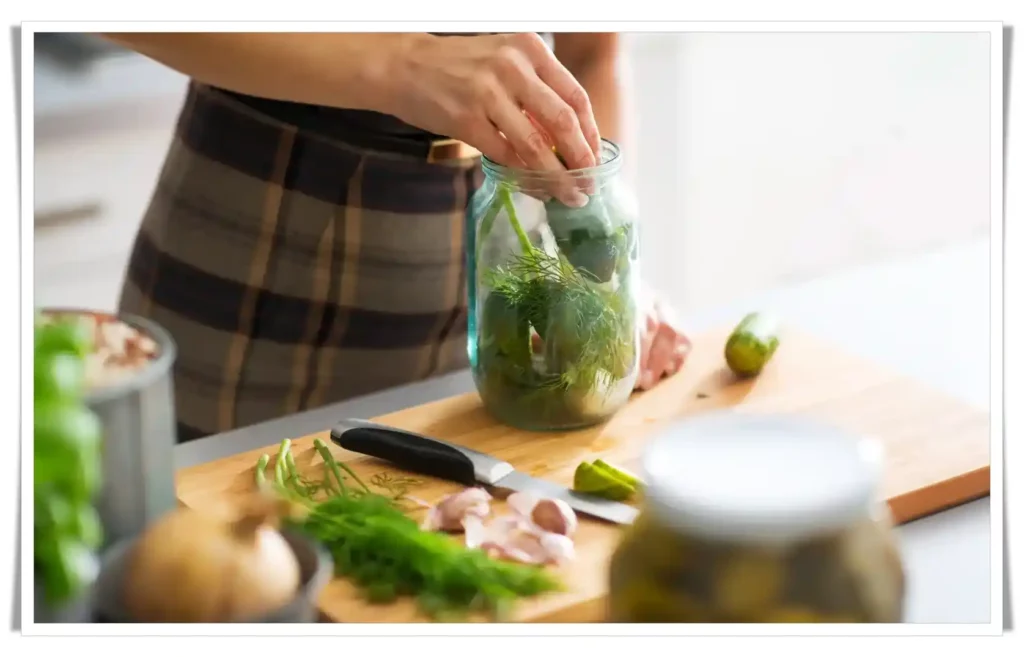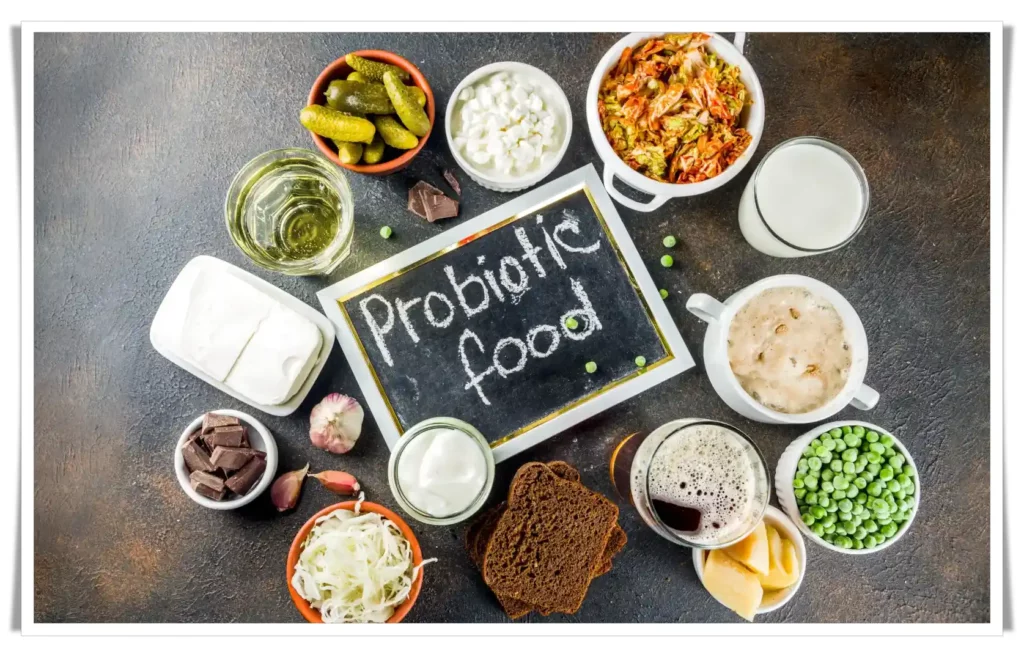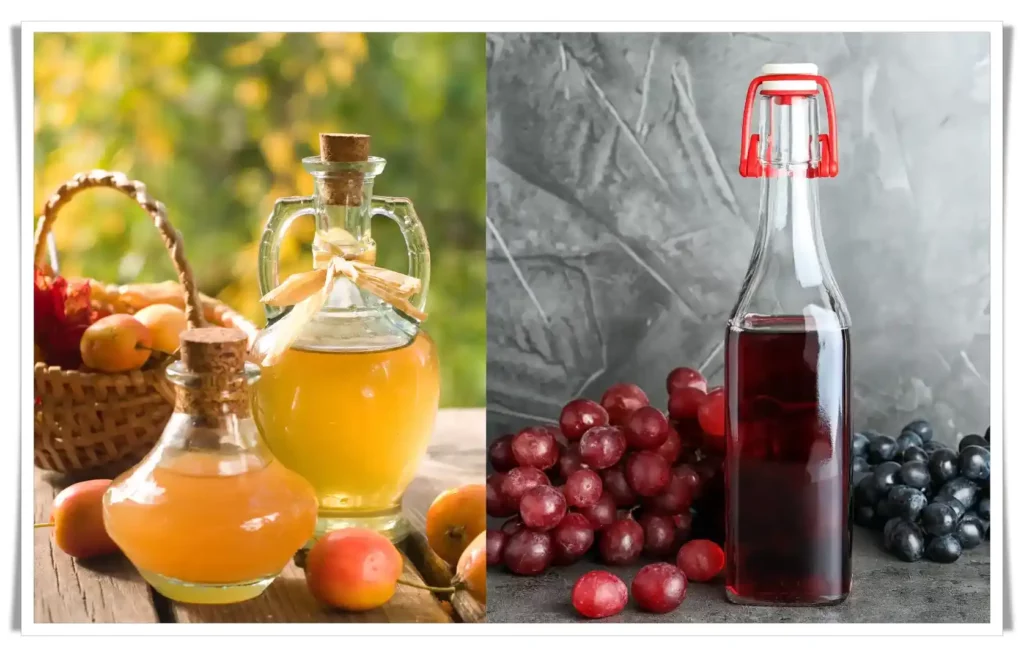Introduction
Situated at the nexus of gastronomic heritage and healthful nutrition, pickling stands as a culinary art form as fascinating as it is beneficial. This ancient preservation technique, which leverages the power of anaerobic fermentation or vinegar immersion, not only extends the shelf-life of food but also enhances its sensory appeal, lending it a unique tangy essence and a satisfyingly crunchy texture that can uplift any meal.
Empower Your Health Journey – Explore My Free Apps for a Vibrant, Healthier Lifestyle Today!
The practice of pickling is a testament to mankind's resourcefulness, dating back to when our ancestors, in the absence of contemporary refrigeration, sought innovative ways to keep their food edible for longer. By employing anaerobic fermentation, they effectively harnessed the activity of beneficial bacteria to transform the sugars naturally present in food into lactic acid. This process, simultaneously preserving the food and imparting it with a characteristic sourness, is the heart of what we understand as fermentation-based pickling today.
Alternatively, food can be preserved by immersion in vinegar, a highly acidic solution that deters spoilage by creating an environment unfavorable for harmful microbes. This method, while not involving fermentation, still results in the tangy, flavorful, and crisp qualities we associate with pickled foods.

What makes the art of pickling stand out, beyond its culinary and preservation roles, is its significant contribution to our health, primarily through the introduction of probiotics into our diet. Probiotics, often referred to as "good bacteria," are live microorganisms that, when consumed in adequate amounts, confer various health benefits. They are especially known for their role in promoting gut health, enhancing immune function, and aiding digestion.
Through the process of fermentation-based pickling, various strains of these beneficial bacteria, such as Lactobacillus, proliferate and thrive. When we consume fermented pickled foods, we introduce these probiotics into our digestive system. Here, they help to maintain a healthy balance of intestinal flora, which is vital for efficient digestion and overall gut health.
Moreover, probiotics also play a vital role in nutrient absorption. They assist in breaking down food into more easily absorbable components, ensuring our bodies can optimally benefit from the vitamins and minerals in our diet.
Thus, pickling is more than a culinary technique or a food preservation method. It's a means of enhancing our diet, enriching our gastronomic experiences, and promoting our health. Whether you're a culinary enthusiast or someone simply looking for ways to boost your diet's nutritional profile, the art of pickling offers a fascinating, flavorful, and healthful avenue to explore.
The Science Behind Pickling: A Deep Dive into Fermentation
The art and science of pickling have been interwoven in human culture for thousands of years. Central to this practice is the natural fermentation process, where microorganisms metabolize sugars in food, converting them into lactic acid. This biochemical transformation serves a dual purpose: it imparts pickled foods with their signature tangy flavor and acts as a natural preservative by creating an acidic environment inhospitable to harmful bacteria.
The fermentation process is facilitated primarily by lactic acid bacteria, a group of Gram-positive, acid-tolerant microbes. As these bacteria consume the sugars present in the food, they metabolize them through a process called lactic acid fermentation, producing lactic acid as a byproduct. This microbial activity lowers the pH of the food, making it more acidic. This increased acidity, in turn, prevents the growth of food spoilage organisms, effectively preserving the food.
A notable example of the scientific exploration into the world of pickling and fermentation is a study titled "Diversity of Microbial Communities and Quantitative Chemodiversity in Layers of Marine Sediment Cores from a Causeway (Korea)" published in the journal "Marine Drugs". This study, while not directly about pickling, provides valuable insights into the microbial communities that drive fermentation, including those involved in the pickling process.

The researchers in the study sought to explore the diversity of microbial communities in marine sediment layers in a causeway in Korea. Through a detailed analysis, they found a wide variety of microorganisms, including various species of lactic acid bacteria, the same group of bacteria instrumental in the pickling process.
In addition to cataloging the bacterial diversity, the study also examined the chemo diversity in the sediment layers. This involved analyzing the various organic compounds produced by these microorganisms, including lactic acid. The researchers found that the quantity and type of these compounds varied significantly depending on the specific bacterial community present.
This study underscores the complexity and importance of microbial communities in various fermentation processes, including pickling. It highlights the pivotal role of lactic acid bacteria and the various compounds they produce in creating the unique sensory and preservation characteristics of pickled foods.
In conclusion, the science behind pickling is a fascinating blend of microbiology, chemistry, and food science. By harnessing the metabolic capabilities of lactic acid bacteria, we can transform simple ingredients into flavorful, long-lasting, and nutritious foods.
Health Benefits of Pickling: A Closer Look at Fermented Foods
The tantalizing tang and satisfying crunch of pickled foods are but the appetizing tip of the iceberg when it comes to the myriad benefits they offer. These delightful delicacies, born out of the harmonious union of natural ingredients and time-honored techniques, serve a rich banquet of health benefits that extend from our taste buds to our gut and beyond.
Improved Digestion: The Probiotic Effect
One of the most significant health benefits of fermented pickled foods is their capacity to improve digestion. The key to this advantage lies in the lactic acid produced during the fermentation process. This acid, along with other organic acids, helps to maintain an optimal pH balance in our gut, creating an environment conducive to beneficial bacteria and detrimental to harmful ones.

The lactic acid bacteria involved in fermentation, such as Lactobacillus and Bifidobacterium, are known probiotics. When consumed, these probiotics can help bolster the community of beneficial bacteria in our gut, often referred to as the gut microbiota. A balanced gut microbiota is crucial for efficient digestion and nutrient absorption, and it can also mitigate digestive issues such as bloating, constipation, and diarrhea.
Enhanced Nutrient Absorption: The Fermentation Advantage
Fermented pickled foods also bring the advantage of enhanced nutrient absorption. The fermentation process naturally breaks down the components of the food, making them more easily digestible. This 'pre-digestion' allows our bodies to more readily absorb the nutrients in the food.
For instance, fermentation can reduce compounds called phytates, which are found in many foods and can inhibit the absorption of certain nutrients like iron and zinc. By decreasing the levels of phytates, pickling can enhance the bioavailability of these essential nutrients, aiding our bodies in reaping their full benefits.
Boosted Immune System: The Power of Probiotics
Beyond their role in digestion and nutrient absorption, the probiotics present in fermented pickled foods also contribute significantly to our immune health. Our gut microbiota plays a pivotal role in our immune system, helping to regulate immune responses and fend off harmful pathogens. By bolstering our gut microbiota, the probiotics in pickled foods can help to strengthen our immune defenses.
Moreover, some studies suggest that these probiotics can help to modulate inflammatory responses, potentially reducing the risk of certain inflammatory conditions.

In essence, pickling transforms simple ingredients into nutrient-dense, probiotic-rich foods that offer a plethora of health benefits. From promoting better digestion and nutrient absorption to bolstering our immune system, pickled foods are a testament to the wisdom of ancient culinary practices and their place in our modern diets.
How to Pickle Foods: A Comprehensive, Step-By-Step Guide
Embracing the art of pickling can transform your culinary repertoire, infusing it with a wealth of flavors and textures that are as versatile as they are delicious. This time-honored technique not only yields food that's rich in taste and nutritional value but also provides an excellent means of preserving a bounty of fresh produce. Here, we present a comprehensive guide to help you delve into this fascinating aspect of gastronomy.
Ingredients
To get started, you'll need the following:
- Fresh vegetables or fruits of your choice. This could include cucumbers, onions, beets, carrots, or even fruits like apples and pears. The world of pickling is vast, and each variety of produce can yield a unique and delightful result.
- Vinegar. The type of vinegar you choose can influence the flavor of the final product. Distilled white vinegar is a versatile choice, but apple cider vinegar can add a fruity tang.
- Salt. Pickling or kosher salt is best as it dissolves easily and doesn't contain additives that might cloud the pickling solution.
- Sugar. This is optional and can be adjusted according to your preference for sweetness.
- Pickling spice or other flavorings. These could include garlic cloves, dill sprigs, mustard seeds, peppercorns, or even red pepper flakes for a touch of heat.

Procedure
Step 1: Prepare the Pickling Solution
The first step is to create the pickling solution. Combine the vinegar, water, salt, and sugar (if using) in a pot. Bring the mixture to a boil over medium heat, stirring occasionally until the salt and sugar have dissolved completely. This forms the acidic brine that will preserve and flavor your vegetables or fruits.
Step 2: Prepare the Vegetables
While the pickling solution is heating, prepare your chosen vegetables or fruits. Clean them thoroughly to remove any dirt, then chop them into your desired sizes. Keep in mind that smaller pieces will pickle more quickly than larger ones. Also, consider how you want to use your pickled produce - thin slices might be perfect for sandwiches, while whole or halved vegetables could be ideal for a crunchy snack.
Step 3: Pack the Jars
Next, prepare your pickling jars. First, add your chosen spices or flavorings to the bottom of each jar. Then, pack your prepared vegetables or fruits into the jars. Be sure to pack them tightly, but ensure that they remain below the top of the jar to allow room for the pickling solution.
Step 4: Pour the Pickling Solution
Once your jars are packed, it's time to add the hot pickling solution. Carefully pour the solution into each jar, making sure to cover the vegetables or fruits completely. It's important to remove any air bubbles trapped in the jar as these could potentially lead to spoilage. You can do this by gently tapping the jars on your countertop or using a clean utensil to move the vegetables around.
Step 5: Seal and Store
Finally, seal your jars tightly and allow them to cool at room temperature. Once cooled, store them in the refrigerator. Though you might be tempted to taste your pickles right away, patience is key - wait for at least 48 hours before consuming them. This allows the flavors to develop fully, resulting in a more flavorful and satisfying pickle.
That's it! With these steps, you're well on your way to mastering the art of pickling. Happy pickling!
Here are some trustworthy websites that offer further insights into the art and science of pickling:
| Website | Description |
|---|---|
| National Center for Home Food Preservation | This website offers a comprehensive guide on home preservation and canning, including pickling. |
| The Kitchn | The Kitchn provides a wide range of recipes and cooking tips, including a guide on how to quick pickle any vegetable. |
| Healthline | Healthline offers reliable information on the health benefits of fermented and pickled foods. |
| Serious Eats | Serious Eats is a trusted source for all things food-related, including the process and recipes for pickling. |
Frequently Asked Questions
We understand that venturing into the world of pickling can come with a lot of questions. Here are answers to some commonly asked queries:
- What kind of vinegar can I use for pickling?
You can use a wide variety of vinegar for pickling, including distilled white vinegar, apple cider vinegar, or wine vinegar. The type of vinegar can influence the flavor of your pickled goods.
- Can I pickle fruits as well as vegetables?
Absolutely! While vegetables are commonly pickled, you can also pickle fruits. Try pickling apples, pears, or even peaches for a tangy, sweet treat.
- How long do homemade pickles last?
Properly stored, homemade pickles can last for up to a year in the refrigerator. However, for the best quality, consume them within two months.
- Why do I need to wait before consuming my pickles?
Waiting allows the flavors to fully develop, resulting in a more flavorful pickle. It's recommended to wait at least 48 hours before tasting your homemade pickles.
Pickling Essentials: Vinegar Varieties
| Type of Vinegar | Flavor Profile | Best Used For |
|---|---|---|
| Distilled White Vinegar | Sharp, Clean | Cucumbers, Onions |
| Apple Cider Vinegar | Fruity, Mildly Sweet | Beets, Apples |
| Wine Vinegar | Wine-like, Fruity | Specialty Pickles |

Example of Vinegar Varieties:
- If you're pickling cucumbers to make traditional dill pickles, you might want to use distilled white vinegar due to its sharp and clean flavor. This vinegar won't overpower the fresh taste of the cucumbers and dill.
- On the other hand, if you're pickling beets, apple cider vinegar could be a good choice. Its fruity and mildly sweet flavor profile complements the natural sweetness of beets very well.
We hope you found this article informative and inspiring. If you have any further questions, comments, or suggestions, please feel free to leave them in the comments section below. We appreciate your feedback and will respond as soon as possible.
If you enjoyed this article, we invite you to also read our piece on weight loss: "Detox to Drop Pounds: Antioxidant Plans for Weight Loss Success". This comprehensive guide offers helpful tips and practical plans to aid your weight loss journey through antioxidant-rich foods.
If you've found the content of this article helpful and are interested in exploring more ways to promote health through what we consume, we highly recommend watching the informative YouTube video, "Pesticide-Free Kids: Can A Simple Rinse Do The Trick?". This video offers practical advice on how to reduce the impact of pesticides on our children's health, a topic of utmost importance for all parents and caregivers. Enjoy watching!
Conclusion
Embracing the art of pickling can do much more than introduce you to a new realm of culinary creativity. It can transform your entire gastronomic journey, opening up a world of tantalizing flavors that can elevate even the simplest of meals. From the tang of pickled cucumbers to the sweet, sour kick of pickled fruits, the possibilities are as varied as they are delicious.
But the benefits of pickling extend far beyond the palate. This age-old technique is also a treasure trove of substantial health benefits. The natural fermentation process that occurs during pickling enhances the nutritional value of food, enriching it with probiotics that aid digestion, boost the immune system, and promote overall gut health. By incorporating pickled foods into your diet, you're not just treating your taste buds; you're also taking a positive step towards better health.
Moreover, pickling is a practical and cost-effective way to preserve food, reducing waste and allowing you to enjoy seasonal produce all year round. Have a bounty of summer cucumbers or autumn apples? Pickling allows you to savor these flavors long after their peak season has passed.
Finally, the joy of pickling lies in its simplicity. With just a few basic ingredients—fresh produce, vinegar, salt, and a selection of spices—you can create a variety of pickled goods right in your own kitchen. It's an engaging, rewarding practice that allows you to truly connect with the food you eat.
So, why wait? Get those jars ready, gather your favorite fruits and vegetables, and embark on your pickling adventure. The world of pickling awaits, promising a culinary journey that's as enriching as it is delicious. Here's to the art of pickling and the many delights it holds!





Wow, superb weblog format! How lengthy have you ever been running a blog for?
you made blogging glance easy. The total look of your website
is fantastic, let alone the content material!
You can see similar: sklep online and here e-commerce
buy ciprofloxacin online cheap – brand bactrim 960mg augmentin over the counter
Everything is very open with a precise description of the issues.
It was really informative. Your site is extremely helpful.
Many thanks for sharing! I saw similar here: Najlepszy sklep